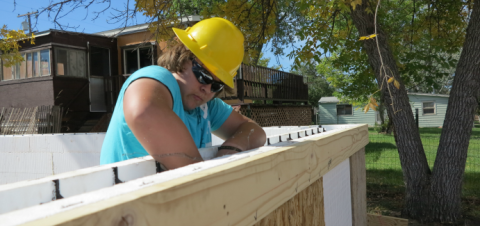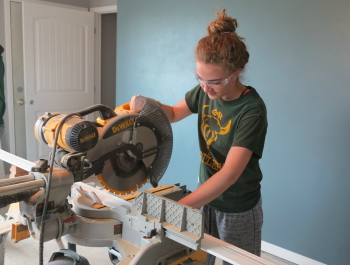Image

Sheila Rice, Executive Director, NeighborWorks Great Falls
Challenge: Great Falls, MT, boasts many beautiful old homes, some dating back more than a century. But the aging houses are interspersed with vacant lots and blighted buildings and the aging neighborhoods urgently needed revitalization. Meanwhile, working families and low-income earners needed affordable housing to break the cycle of poverty.
Great Falls, MT, is rich in history. The magnificent falls on the Missouri River proved one of the most challenging stretches for the Lewis and Clark expedition. The arrival of the railway in the 1880s brought a boom to the town and the beginnings of an architecturally rich era. Today homes from the city’s storied past include styles su ch as Colonial, Revival, Queen Anne, Victorian, Second Empire and Craftsman. But these beautiful houses often sit alongside vacant lots and blighted buildings, discouraging new homebuyers from settling in the neighborhoods.
NeighborWorks Great Falls (NWGF) was founded in 1980 with a mission to revitalize the city’s historic neighborhoods, provide affordable housing and help residents become first-time homebuyers. A primary strategy in our work is collaboration with local partners, and one of the most significant examples of this is our High School House program.
NWGF joined forces with Great Falls public schools and the city to create the program, which provides new homes for residents with low or moderate incomes and gives high school students valuable employment skills. In the past 18 years, students from the Great Falls and C. M. Russell high schools have built 37 homes on vacant lots in historic neighborhoods. The students provide the labor while the city contributes community development block grant funding. NWGF supplies the lot, arranges subcontractors and finances the construction. We also work with potential homebuyers to get them mortgage-ready with homebuyer education, individual homeownership planning and down payment assistance through a matched savings program. The buyers must be first-time homeowners, and many have become first generation homeowners.
This fruitful partnership has produced multiple advantages on all sides. The students get to work in an outdoor worksite two hours a day all school year long, escaping from the confines of the classrooms. Some who were at high risk for dropping out of school stay to work on the High School House Program and graduate with their class. The off-campus classroom settings provide real-world work environments -- snow, wind and high temperatures -- everything a construction worker must endure. The program also equips the students for future career path decisions and useful training they can put into practice right away. Frequently, local builders and subcontractors visit High School House teachers at the end of the school year and ask: “Which of these kids are ready to come to work?” Some students realize that the labor side of the construction trade is not for them, so they continue their education, often in engineering or architecture. Still, that one year in construction offers them skills that last a lifetime.
 Landon Stubbs came from a construction family and figured he did not need a high school diploma to make a living. But when he had the opportunity to work with the High School House program his senior year, he decided to finish school and graduate. Building a house made Stubbs realize how much he loved the program and loved teaching other students how to build, so he went to college to get his degree in industrial arts education. In less than three years, Landon landed what he calls his dream job as a High School House Program teacher. “I am one lucky guy,” he says.
Landon Stubbs came from a construction family and figured he did not need a high school diploma to make a living. But when he had the opportunity to work with the High School House program his senior year, he decided to finish school and graduate. Building a house made Stubbs realize how much he loved the program and loved teaching other students how to build, so he went to college to get his degree in industrial arts education. In less than three years, Landon landed what he calls his dream job as a High School House Program teacher. “I am one lucky guy,” he says.The program is a plus for the city since the tax base increases when a new home replaces a vacant lot or blighted building. The school district benefits from higher graduation rates and the positive visibility of its contribution to the community. And, of course, the homebuyers come away with a brand new, quality-built home that they can afford thanks to the students’ free labor and the deferred mortgage program. “Homeownership changed my family’s future. In one day, we went from poverty to middle class,” says High School House homebuyer Erika Graves
The neighbors around the High School Houses love the idea that their community is improving and new homebuyers are moving in. The construction projects also bring people to the neighborhoods they would not ordinarily visit, as they drop by to see their children and grandchildren working or to attend ground breaking and completion open houses.
NWGF has reaped considerable rewards from the High School House program. It allows us to build two new homes every year and promotes our mission to provide affordable housing. The program’s high visibility builds awareness of all of our lines of work, such as homebuyer education and neighborhood engagement. The High School House Program involves non-construction students in interior design, landscaping, welding and food services (to cater the Open House Celebration). NWGF has also come away with valuable lessons: seeking partnerships can provide support from untapped or unrecognized resources, and engaging the community in our work promotes our mission and raises awareness of our services.

